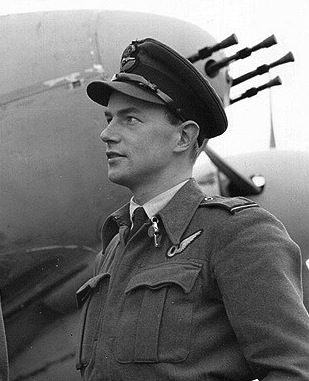

Flight Lieutenant Robert Bruce D.F.C. and Bar
Flight Lieutenant Robert Bruce D.F.C. and Bar
Born: August 17th 1915, Inverkeiler, Scotland. Died: August 13th 2012 Age 96

The pair joined No 418 (RCAF) Squadron in June 1944 to fly night intruder missions, and claimed their first success a week later when they shot down a Luftwaffe night fighter over a French airfield.
Within days the Germans launched the V-1 attacks against London, and No 418, with its fast-flying Mosquito aircraft, was sent on night patrols to intercept and destroy them.
Bannock and his navigator Bruce decided that the best way to stop the flying bombs (code-named “Divers”) was to catch them just after they were launched from their sites in the Pas de Calais.
On July 3 they headed for Abbeville and arrived to see a stream of Divers being launched.
Despite coming under heavy fire from anti-aircraft guns, they attacked and destroyed three.
Three nights later they intercepted and destroyed four in one mission; two more fell to their guns the following night.
By mid-August they had accounted for another 10, making them one of the most successful Allied crews against the flying bombs.
Both men were awarded DFCs.
The great grandson of James Bruce, the 8th Earl of Elgin and 12th Earl of Kincardine, Robert Richard Fernie Bruce was born at Inverkeiler, Scotland, on August 17 1915 and educated at Rugby, before taking a First in Music at Edinburgh University.
From early childhood, he had been an outstanding cellist and accomplished pianist, and, after leaving Edinburgh, he travelled to Switzerland to study the cello.
He then moved to Amsterdam for tuition with Rafael Lanes, and under Johannes Roentgen he studied composition.
Bruce started the war as a pacifist, and worked with the Friends Ambulance Service during the London Blitz. He was then posted to Gloucester Royal Hospital, where he met a smart (and forceful) sister whom he later married.
Early in 1942 he altered his stance as a conscientious objector and enlisted in the RAF.
Training as a navigator in Canada, he met Russ Bannock, who was an instructor, and they teamed up at the Mosquito training unit before travelling to England and joining No 418 at Middle Wallop in Hampshire.
The squadron’s role was intruder operations in support of Bomber Command’s night bombing offensive.
Single Mosquitos flew to enemy-held airfields in north-west Europe to intercept and shoot down enemy night fighters as they took off and landed. If they failed to intercept aircraft, they were tasked to attack rail and road transport.
In mid-August 1944, after its successful campaign against the Divers, No 418 reverted to intruder sorties. On August 29, Bruce and Bannock headed for an airfield near Copenhagen, where they shot down a Junkers 88 and destroyed a Messerschmitt Bf 110.
Two weeks later they shot down an enemy night fighter as it was about to land, and on the night of September 27/28 they flew to a training airfield where they destroyed two Messerschmitts.
As they pulled away from the airfield at Parrow, a Bf 109 attacked, and the Mosquito’s starboard engine was damaged before they made their escape.
They returned the 600 miles over enemy territory on one engine.
Bannock was promoted to Wing Commander and posted to command No 406 (RCAF) Squadron, Bruce accompanying him as the squadron’s navigation training officer.
They opened their account on December 24 by shooting down a Junkers 88 over Paderborn airfield. Further successes followed .
In February 1945 Bruce was awarded a Bar to his DFC.
He was released from the RAF in 1946 and initially worked as a teacher in Brighton. He then became a lecturer in Music at Cardiff University.
Throughout the war, Bruce had found time to play music, having added the oboe to his repertoire, and to compose.
Shortly after returning to civilian life he started work on a symphony which he completed a few years later.
It was performed by the Toronto Symphony Orchestra and recorded in studios in Poland.
After retiring in 1977, Bruce and his wife renovated a cottage at Llechryd, South Wales, where they also created and tended a beautiful one-acre garden .
Robert Bruce married, in 1941, Beatrice Tomboline. She died in 2010, and he is survived by a son and a daughter; an elder son predeceased him.
If you have additional information or photographs to add to this Obituary please contact us.
We also seek to commemorate all those not published by The Daily Telegraph and would be pleased to receive your contributions.
Article prepared by Barry Howard.
• Last Modified: 01 January 2014, 00:00 •

